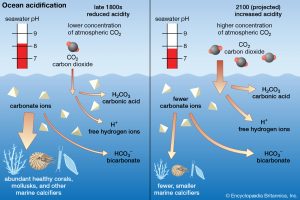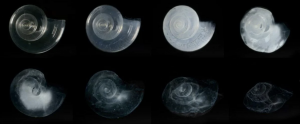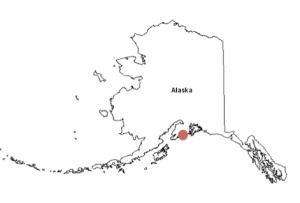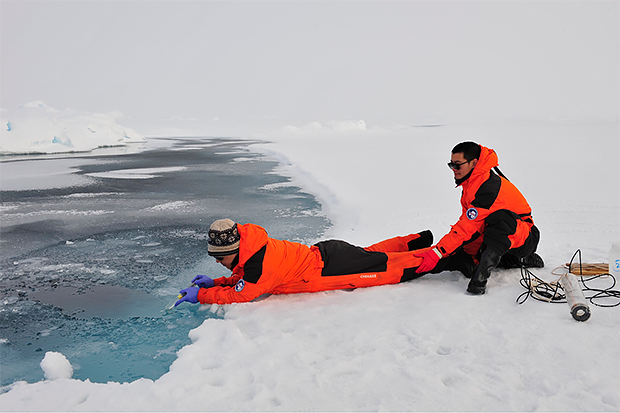Hi, everyone! This page is dedicated to the issue of ocean acidification. What exactly it is, how it affects various systems in the Arctic region, and what people are doing about it. Hopefully you can gain some insight on this pressing matter while staying optimistic about sustainable paths forward! Maybe it’ll even inspire future careers in climate work. Here we go!
Ocean Acidification – Chemistry
– Ocean acidification refers to an increase in the acidity of the ocean caused primarily by the uptake of carbon dioxide from the atmosphere, followed by chemical reactions in the water that acidifies the saltwater (IPCC Report).
– Oceans have absorbed between 24 and 33% of anthropogenic carbon dioxide emissions during the past five or six decades (Billé 2013, 762).
– Arctic waters are particularly vulnerable to ocean acidification due to the low temperature of polar waters compared to other waters and the higher capacity of cold waters to absorb carbon dioxide (Bates, Cai, and Mathis 2011, 197).

What Happens to Shelled Organisms?
– Shelled organisms such as corals, oysters, crabs, pteropods, and other shellfish depend on carbonate ions and minerals to build their shells and skeletons (AMAP 2013, 3).
– Increases in ocean acidity reduces the concentration of carbonate ions, leading to corrosion of shells and skeletons, and a very stressful environment for all species.
– Not only does ocean acidification have a large impact on marine ecosystems, but also on commercial and subsistence fisheries, tourism, other sectors that depend on these ecosystems.

Check out this video on Northwest Shellfish:
Collaborative Solutions: Alutiiq Pride Shellfish Hatchery
A great example of collaboration at multiple levels of governance can be found at the Alutiiq Pride Shellfish Hatchery (APSH) located on the Shore of Resurrection Bay in Seward, Alaska. As the sole shellfish hatchery in the state, APSH is working to understand the effects of ocean acidification on red and blue king crabs and various other species that play a crucial role in AK’s economy and traditional ways of life (Gentile 2017 and Evans et al. 2015, 3).

– APSH has an ocean acidification continuous monitoring system and a dosing lab to test various oceanographic conditions on marine larvae (CRRC, n.d.).
– It has also initiated a region-wide sampling program with 7 Indigenous villages and science partners in AK and the United States: University of Alaska Fairbanks, Chugach Regional Resources Commission, National Oceanic Atmospheric Association, the National Park Service, and the Bureau of Indian Affairs
Click here for a closer look at the APSH:
Policy Recommendations:
Ocean acidification is going to have varying effects all over the Arctic region, and so the identification of areas within the social-ecological system that are most vulnerable can help develop localized and specialized policies to reduce risk.
Policies (including research):
– Collaborative platforms whereby local, state and federal governments, scientists, professionals, citizens, and local businesses can communicate with each other on best practices and implementation of sustainable policies
– Future research should take a multi-stressor approach, given the inter-relationships, interactions and feedbacks between acidification and other environmental stressors
– Indigenous peoples’ and traditional knowledge should be better involved in regional, national and international processes, including coastal monitoring in response to the effects of acidification in their regions (AMAP 2018, 50).
– Actions on resilience should be directed towards providing communities with flexible, economic and ecological adaptation choices (e.g. economic diversification beyond the fishing sector)
– Ultimately, ocean acidification and climate change can only be mitigated by global action (reduction in worldwide, anthropogenic carbon dioxide emissions).
Watch this video for a more in depth discussion of Ocean Acidification in the Arctic and the APSH:
[ensemblevideo version=”5.6.0″ content_type=”video” id=”cc2a86c2-166d-4f03-8780-acd88f0fd422″ width=”848″ height=”480″ displaytitle=”true” autoplay=”false” showcaptions=”false” hidecontrols=”true” displaysharing=”false” displaycaptionsearch=”true” displayattachments=”true” audiopreviewimage=”true” isaudio=”false” displaylinks=”true” displaymetadata=”false” displaydateproduced=”true” displayembedcode=”false” displaydownloadicon=”false” displayviewersreport=”false” embedasthumbnail=”false” displayaxdxs=”false” embedtype=”responsive” forceembedtype=”false” name=”Ocean Acidification in the Arctic”]
